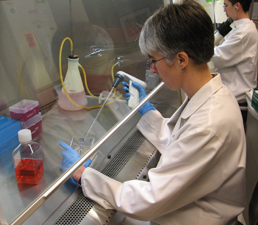 The pace of discovery in stem cell research went into overdrive recently as scientists unveiled new methods for returning mature adult cells (such as skin cells) to an immature, embryonic-like state. The implications for both scientists and patients are vast, suggesting that these "induced pluripotent stem cells" (iPS cells) can one day be used to generate and replace any cell in the human body, or to create laboratory cell lines that model a specific disease from a specific patient, without resorting to the use of embryos.
The pace of discovery in stem cell research went into overdrive recently as scientists unveiled new methods for returning mature adult cells (such as skin cells) to an immature, embryonic-like state. The implications for both scientists and patients are vast, suggesting that these "induced pluripotent stem cells" (iPS cells) can one day be used to generate and replace any cell in the human body, or to create laboratory cell lines that model a specific disease from a specific patient, without resorting to the use of embryos.
HSCI investigators, recognizing the broad applications for the technology and the need for further improvement, established an iPS Core facility. Located at Massachusetts General Hospital, the shared facility serves as a central lab to derive and store the iPS cells produced by HSCI scientists and makes them available to the scientific community.
Just one month after establishing the facility, HSCI researchers were creating new diseasespecific iPS stem cell lines at a prodigious rate.
Harvard scientists George Daley, MD, PhD, Chad Cowan, PhD, and Konrad Hochedlinger, PhD, announced they had produced over 20 cell lines made from skin cells of patients with Parkinson's Disease, Type I diabetes, Huntington's Disease, Down Syndrome, a form of combined immunodeficiency ("Bubble Boy's Disease"), Lesch-Nyhan syndrome, Gaucher's Disease, and two forms of Muscular Dystrophy.
These cell lines were added to those produced by HSCI investigator Kevin Eggan, PhD, which were derived from patients suffering from amyotropic lateral sclerosis (Lou Gehrig's disease).
Moving forward, priority will be given to the development of cellular models for nervous system diseases, blood diseases, kidney disease, cardiovascular disease, and diabetes.
These "diseases in a dish" will permit scientists to watch their development in the laboratory, separate from the patient. In addition to helping us understand the mechanism of a disease, these cells will help us find new drugs.
By screening chemical compounds on the cells, it may be possible to find drugs that affect that cell type and can slow or stop the progression of a disease. Screening on disease specific human cells will enable us also to learn much more about a drug, its effect, and its safety before it is given to a single patient. Daley, chairman of the faculty steering committee that oversees the iPS Core, holds out much hope for its potential to contribute greatly to our knowledge.
"Our work is just the beginning for studying thousands of diseases in a Petri dish," said Daley.
Having a centralized resource allows HSCI's individual laboratories to focus on the biology of human disease, without having to develop the specialized skills or maintain their own resources for the creation, storage and dissemination of iPS-derived cell lines. The iPS Core is also better equipped to adapt rapidly to the changes caused by a technology that is new and evolving (for example, including the discovery of "safer," i.e., non-carcinogenic, factors for converting cells to an embryonic state).
The core also provides a critical link between the research laboratory and the clinic by drawing on the patients seen in the Harvard hospital network. Patients with ALS, Parkinson's disease, cardiovascular disease, diabetes, obesity/metabolic syndrome, and many other diseases who are undergoing treatment at HSCI-affiliated institutions are recruited for enrollment. At the time of enrollment, historical and demographic data are obtained, along with the patient's medical history and laboratory results, and stored in a secure database.
Coding of the donated skin samples completes the connection between scientific discovery of disease mechanisms and patient history, opening the door to new insights.
One day, iPS cell lines will become much more than just a tool for studying disease in a laboratory. By regenerating healthy cells from patients, it may be possible to use them to replace damaged or malfunctioning tissue responsible for many incurable, chronic diseases.
The current iPS technology, which relies on retroviruses with the potential to trigger tumor growth, falls short of that promise. One of the key objectives of the iPS Core Facility is to improve the technology and identify factors that induce pluripotency, but do not put the patient at risk. Recent studies by Hochedlinger and HSCI co-Director Doug Melton, PhD, using alternative viral or chemical factors suggest that objective might be within reach in the near future.
